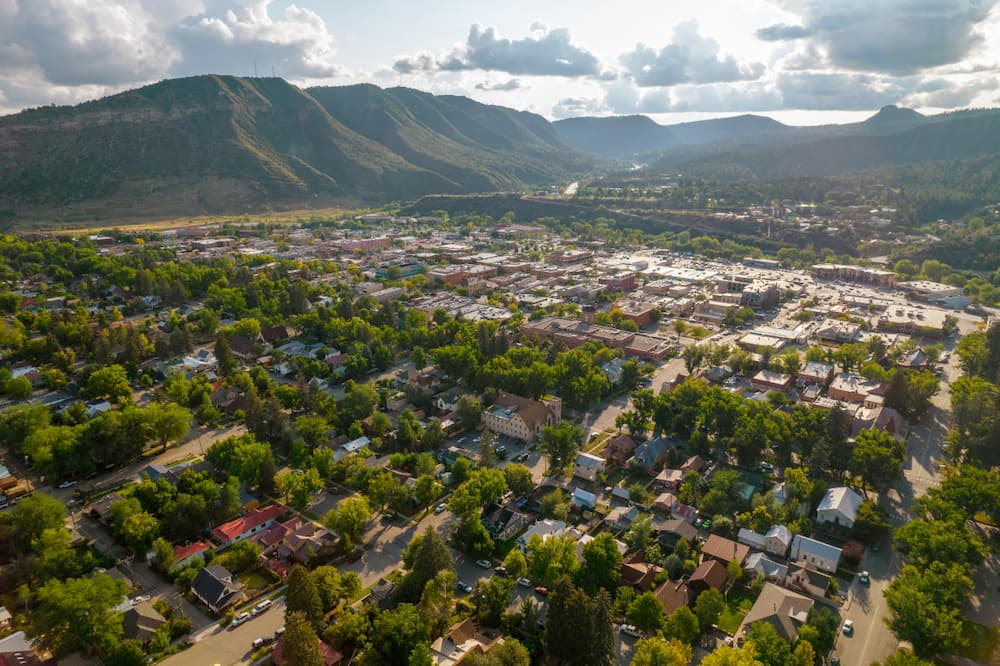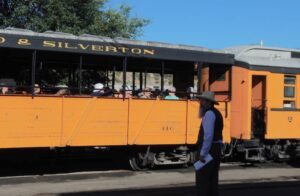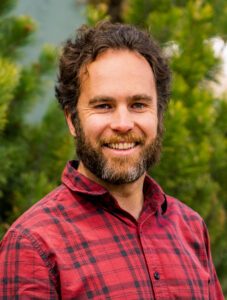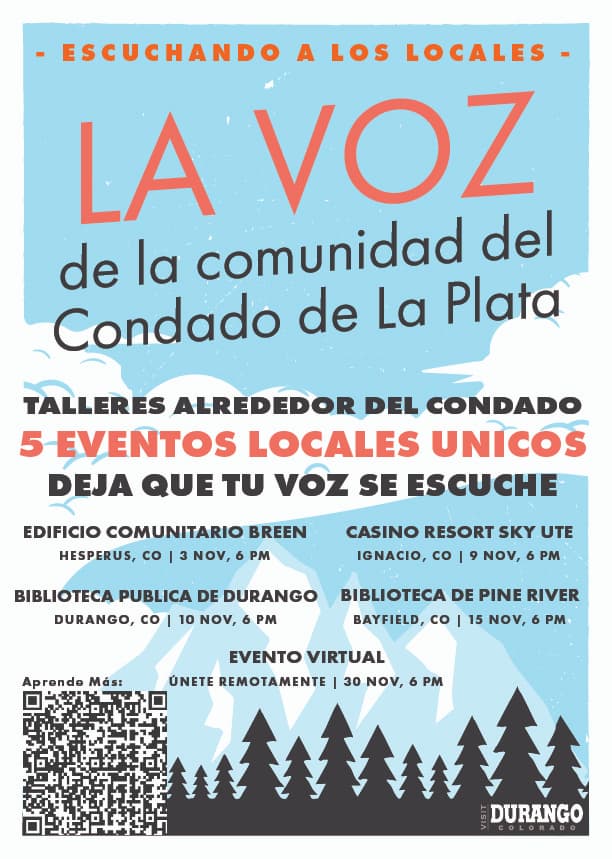Destination Stewardship Report – Volume 4, Issue 3
This post is from the Destination Stewardship Report, a publication that provides practical information and insights useful to anyone whose work or interests involve improving destination stewardship in a post-pandemic world.

Durango by drone. All photos courtesy Visit Durango.
A Colorado Community Shows How To Get Started
Spurred on by the post-pandemic era of travel, tourism organizations are moving away from a singular function of marketing destinations. Some have begun to incorporate “destination stewardship” into plans, functions, and even job titles. Sarah-Jane Johnson reports on how one of Colorado’s renowned recreational destinations has gone about doing it.
A Colorado Community Shows How To Get Started
Increasingly, tourism organizations have been adopting the identity of destination management or stewardship organizations to officially charter tourism management rather than just promoting places. But destination stewardship must go deeper than a job title; it means collaborating with other caretakers and stakeholders, including those who live there.
In southwestern Colorado, the community of Durango voted to secure funds that will forever be dedicated to sustainable tourism. Now Visit Durango, the local tourism organization for La Plata County and the city of Durango, has a dedicated staffer who is knocking on doors and walking the streets to talk tourism with residents—an authentic effort of destination stewardship that has been well received and is shaping visitor experiences.
How it Started: The Voters Speak

Tourists aboard the Durango scenic railway await departure. Photo: Jonathan Tourtellot
Visit Durango’s journey towards destination stewardship started in 2019 when a newly appointed executive director, Rachel Brown, set about reviewing ways to grow a stagnant operational budget. An analysis revealed that lodging tax collections were significantly lower than comparable destinations. At that time, pre-Covid-19, increasing visitation was placing pressure on the community infrastructure in the famed recreational destination, in turn leading to negative resident sentiment towards the tourism industry, according to Weylin Ryan, a born-and-raised Durangoan. Ryan was eventually tasked with developing a sustainable tourism approach when he was appointed as Visit Durango’s first ever Sustainability and Policy manager in 2022.
Under Brown, Visit Durango spearheaded a ballot initiative in 2021 to increase the “Lodger’s Tax” from 2% to 5.25%. Voters were enticed to the Yes vote by the promise that future lodging tax collections would be split across three areas of community-favored needs: arts and cultural event programming; local transportation; and sustainable tourism programming (which would receive 55% of the lodging tax income). With this as official ballot language, the voters of Durango were mandating a sustainable tourism future.
Visit Durango’s First Sustainability Manager

Durango’s Weylin Ryan
While Ryan had been employed in various local tourism jobs throughout his career, he was hired by Visit Durango in January 2022 with an official remit to oversee tourism management and sustainability.
He brought with him his philosophy favoring community-led tourism, shaped by his education and ISO 2600 professional development training in social responsibility standards and community development.
Ryan described the first ten months on the job as being spent identifying strategies to help Visit Durango undertake sustainability. Through a review of appropriate GSTC-Recognized Standards such as Mountain IDEAL, and GSTC Destination Criteria A4 and A5 addressing stakeholder engagement and resident engagement and feedback, he understood that a new mode of operation was needed. “With sustainable tourism – and tourism in general – it really does need to be led by the community instead of government or business,” says Ryan.
What Success Looks Like
Since early 2023, Visit Durango’s suite of engagement mechanisms include:
- A dedicated tourism engagement and education website for resident input along with status updates on tourism development projects.
- “Listening to Locals” tourism town hall meetings that provided open house settings for locals to meet and share their ideas with Visit Durango.
- An annual resident survey on tourism, so Visit Durango can see if awareness and education is increasing and gather more feedback on projects.
Getting this input has helped shape visitor-experience product development, while also providing locals a chance to tell tourism officials which assets they care about or want to see preserved and protected from overtourism.

La Plata county flier
In 2024, Visit Durango will launch an online learning course that locals can complete to learn about the broader local tourism industry and destination information. And there is a prize for doing so: Visit Durango will reveal details about a locals incentive program to encourage locals to participate later this year. Another program set to launch, titled All Are Welcome, is designed to offer tourism business managers and frontline workers gender-identity training and accessibility education, along with local cultural heritage via stories distinctive to la Plata County.
Visit Durango has also shifted its marketing audience to reach locals with responsible travel messaging. “We are doing marketing (campaigns) within a 50-mile radius of La Plata County and inside the county. Our marketing dollars do not just go towards inviting more visitors in, but also to informing residents and visitors on campaigns such as avalanche safety or wildfire safety,” said Ryan. Visit Durango also provides Spanish and other language materials in its welcome center that can be printed on demand.
But Ryan attests the most success he’s had is from his effort to pound the pavement of La Plata County. To reach all demographics of the community, he spent two days last year hand-delivering Spanish-translated fliers about resident tourism surveys throughout lower-income community neighborhoods. He also drove across the sprawling rural county to hold targeted meetings with groups that included agricultural workers and firefighters, hoping to hear from all corners of the county and all local voices.
Lessons Learned About Community Engagement
According to Ryan and Visit Durango, successful community engagement comes from:
- Identifying Your Stakeholders: Conduct stakeholder mapping to understand your tourism community and potential partners or groups to build relations with.
- Building Authentic Relationships: Get into the community to build connections by participating in community events or attending meetings – or even just to show up and listen.
- Asking First: Inquire about how the community wants to be presented to tourists and what is appropriate, so as to create visitor programming that is culturally and environmentally intentional.
- Being an Active Listener: Don’t speak –listen first – to understand the dialogue among residents and what they care about.
- Getting Feedback: Create a review process via community members on tourism committees to get input and feedback on campaigns and projects.
- Customizing the Approach: Target and adapt the outreach or conversation to ensure groups are being met the right way.
“[Tourism] should be what the community wants. Let’s start with them and build it up,” concluded Ryan in describing a tourism development process. “Start there, add some marketing, and then it will be successful.”
Elsewhere: Other Engagement Best Practices
- The Colorado Tourism Office (CTO) is in a year-long effort to develop one statewide and eight regional destination stewardship plans. To raise awareness and spread the word, the CTO created a communications toolkit for tourism stakeholders that included email, press releases, and social media boilerplate language that could easily be copied and pasted, as well as fact sheets with tourism terminology. (In 2021, the CTO also became the first state tourism office with a destination stewardship department.)
- The Jackson Hole Travel and Tourism Board (JHTTB) reoriented its marketing effort to reach the local community during its 15-month process to develop a sustainable destination management plan. During that time, staff and board members increased local media engagement through letter-writing campaigns, and also penned opinion columns to speak directly to the community. This outreach effort, which saw 4,777 residents complete a sentiment survey and more than 200 attend in-person community meetings, led to a truly community-shaped vision for Jackson Hole’s tourism.
- Visit Taos is in the final stages of developing a sustainable destination management plan which has driven increased community dialogue around tourism through an awareness campaign.
- Los Angeles Tourism has recast itself as a DSO, a destination stewardship organization, with a mission to improve the quality of life for all Angelenos.
About the Author
Sarah-Jane Johnson is a DSR contributing editor and liaison for Colorado stewardship councils and the Rocky Mountain region.




